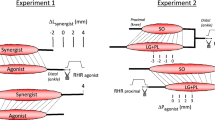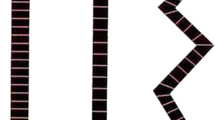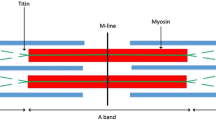Abstract
Eccentric contractions, where the active muscle is stretched, can lead to muscle damage. One of the signs of damage is a rise in the whole-muscle passive tension. Here we have asked, how many eccentric contractions are necessary to produce a measurable rise in passive tension and can this be detected by the muscle's tension sensors, the tendon organs? Responses of tendon organs of the medial gastrocnemius muscle of the anaesthetised cat were recorded during and after a series of eccentric contractions. The contractions were arranged so that the length change to which the muscle was subjected lay symmetrically about the optimum length for active tension. Tendon organ responses were measured as a mean rate, calculated over a 1-mm length change during a slow stretch of the muscle. Progressive increases in passive tension and tendon organ response were measured after each of a series of 1–100 eccentric contractions of the whole muscle, bundles of motor units and single motor units. One to two eccentric contractions of a single motor unit were sufficient to produce measurable rises in passive tension and tendon organ response. After a series of eccentric contractions had been completed, passive tension and tendon organ response were seen to continue rising with similar time-courses over the next 50 min. Both tension and afferent response could be reduced by large passive stretches. There was also a large increase in the responses of tendon organs to combined stretch and vibration at 100 Hz after the eccentric contractions. All of this indicates that tendon organs are able to monitor the passive tension changes in the muscle, thought to result from muscle damage produced by the eccentric contractions. The findings are relevant to known changes in proprioception and motor control after eccentric exercise.






Similar content being viewed by others
References
Balnave CD, Allen DG (1995) Intracellular calcium and force in single mouse muscle fibres following repeated contractions with stretch. J Physiol 488:25–36
Barker D (1974) The morphology of muscle receptors. In: Hunt CC (ed) Handbook of sensory physiology, vol. III, part 2 Springer, Berlin Heidelberg New York, pp. 1–190
Brockett C, Warren N, Gregory JE, Morgan DL, Proske U (1997) A comparison of the effects of concentric versus eccentric exercise on force and position sense at the human elbow joint. Brain Res 771:251–258
Brockett CL, Morgan DL, Gregory JE, Proske U (2002) Damage to different motor units from active lengthening of the medial gastrocnemius muscle of the cat. J Appl Physiol 92:1104–1110
Brooks SV, Faulkner JA (1996) The magnitude of the initial injury induced by stretches of maximally activated muscle fibres of mice and rats increase in old age. J Physiol 497:573–580
Brown MC, Engberg I, Matthews PB (1967) The relative sensitivity to vibration of muscle receptors of the cat. J Physiol 192:773–800
Carson RG, Riek S, Shahbazpour N (2002) Central and peripheral mediation of human force sensation following eccentric or concentric contractions. J Physiol 539:913–925
Chleboun GS, Howell JN, Conatser RR, Giesey JJ (1998) Relationship between muscle swelling and stiffness after eccentric exercise. Med Sci Sports Exerc 30:529–535
Fridén J, Lieber RL (1998) Segmental muscle fiber lesions after repetitive eccentric contractions. Cell Tissue Res 293:165–171
Gordon AM, Huxley AF, Julian FJ (1966) The variation in isometric tension with sarcomere length in vertebrate muscle fibres. J Physiol 184:170–192
Gregory JE (1990) Relations between identified tendon organs and motor units in the medial gastrocnemius muscle of the cat. Exp Brain Res 81:602–608
Gregory JE, Proske U (1979) The responses of Golgi tendon organs to stimulation of different combinations of motor units. J Physiol 295:251–262
Gregory JE, Proske U (1981) Motor unit contractions initiating impulses in a tendon organ in the cat. J Physiol 313:251–262
Gregory JE, Harvey R J, Proske U (1977) A 'late supernormal period' in the recovery of excitability following an action potential in muscle spindle and tendon organ receptors. J Physiol 271:449–472
Gregory JE, Brockett CL, Morgan DL, Whitehead NP, Proske U (2002) Effect of eccentric muscle contractions on Golgi tendon organ responses to passive and active tension in the cat. J Physiol 538:209–218
Howell JN, Chleboun G, Conatser R (1993) Muscle stiffness, strength loss, swelling and soreness following exercise-induced injury in humans. J Physiol 464:183–196
Jami L (1992) Golgi tendon organs in mammalian skeletal muscle: functional properties and central actions. Physiol Rev 72:623–666
Jones DA, Newham DJ, Clarkson PM (1987) Skeletal muscle stiffness and pain following eccentric exercise of the elbow flexors. Pain 30:233–242
Jones C, Allen T, Talbot J, Morgan DL, Proske U (1997) Changes in the mechanical properties of human and amphibian muscle after eccentric exercise. Eur J Appl Physiol Occup Physiol 76:21–31
Macpherson PCD, Dennis RG, Faulkner JA (1997) Sarcomere dynamics and contraction-induced injury to maximally activated single muscle fibres from soleus muscles of rats. J Physiol 500:523–533
Matthews PBC (1972) Mammalian muscle receptors and their central actions. Edward Arnold, London
McBride TA, Stockert BW, Gorin FA, Carlsen RC (2000) Stretch-activated ion channels contribute to membrane depolarization after eccentric contractions. J Appl Physiol 88:91–101
Morgan DL (1990) New insights into the behavior of muscle during active lengthening. Biophys J 57:209–221
Ogilvie RW, Armstrong RB, Baird KE, Bottoms CL (1988) Lesions in the rat soleus muscle following eccentrically biased exercise. Am J Anat 182:335–346
Proske U (1993) The Golgi tendon organ. In: Dyck PJ, Thomas PK (ed) Peripheral neuropathy, vol 1. WB Saunders, Philadelphia, pp. 141–148
Proske U, Morgan DL (2001) Muscle damage from eccentric exercise: mechanism, mechanical signs, adaptation and clinical applications. J Physiol 537:333–345
Proske U, Weerakkody NS, Percival P, Gregory JE, Morgan DL (2002) Tendon organs signal the damage from eccentric exercise. In: Proceedings of the Satellite Symposium of the 3rd Forum of European Neurosciences: Motor Control and Proprioception, Paris, 9–12 July, P2
Saxton JM, Clarkson PM, James R, Miles M, Westerfer M, Clark S, Donnelly AE (1995) Neuromuscular dysfunction following eccentric exercise. Med Sci Sports Exerc 27:1185–1193
Takekura H, Fujinami N, Nishizawa T, Ogasawara H, Kasuga N (2001) Eccentric exercise-induced morphological changes in the membrane systems involved in excitation-contraction coupling in rat skeletal muscle. J Physiol 533:571–583
Talbot JA, Morgan DL (1998) The effects of stretch parameters on eccentric exerciseinduced damage to toad skeletal muscle. J Muscle Res Cell Motil 19:237–245
Weerakkody NS, Whitehead NP, Canny BJ, Gregory JE, Proske U (2001) Large-fiber mechanoreceptors contribute to muscle soreness after eccentric exercise. J Pain 2:209–219
Weerakkody NS, Percival P, Morgan DL, Gregory JE, Proske U (2003) Matching different levels of isometric torque in elbow flexor muscles after eccentric exercise. Exp Brain Res 149:141–150
Whitehead NP, Weerakkody NS, Gregory JE, Morgan DL, Proske U (2001) Changes in passive tension of muscle in humans and animals after eccentric exercise. J Physiol 533:593–604
Whitehead NP, Morgan DL, Gregory JE, Proske U (2003) Rises in whole-muscle passive tension of mammalian muscle after eccentric contractions at different lengths. J Appl Physiol (in press)
Yeung EW, Balnave CD, Ballard HJ, Bourreau JP, Allen DG (2002a) Development of T-tubular vacuoles in eccentrically damaged mouse muscle fibres. J Physiol 540:581–592
Yeung EW, Bourreau JP, Allen DG, Ballard HJ (2002b) Effect of eccentric contraction-induced injury on force and intracellular pH in rat skeletal muscles. J Appl Physiol 92:93–99
Author information
Authors and Affiliations
Corresponding author
Rights and permissions
About this article
Cite this article
Gregory, J.E., Morgan, D.L. & Proske, U. Tendon organs as monitors of muscle damage from eccentric contractions. Exp Brain Res 151, 346–355 (2003). https://doi.org/10.1007/s00221-003-1508-3
Received:
Accepted:
Published:
Issue Date:
DOI: https://doi.org/10.1007/s00221-003-1508-3




